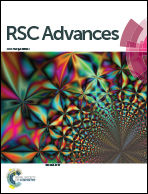Chroman-4-one and pyrano[4,3-b]chromenone derivatives from the mangrove endophytic fungus Diaporthe phaseolorum SKS019†
Abstract
Seven new compounds: diaporchromanones A–D (1–4), (−)-phomopsichin A (5a), (+)-phomopsichin B (6a), and (±)-diaporchromone A (7), along with the known (+)-phomopsichin A (5b) and (−)-phomopsichin B (6b) were isolated from an endophytic fungus Diaporthe phaseolorum SKS019. The structures of the new compounds, including their absolute configurations, were determined on the basis of HRESIMS and NMR spectroscopic data, and experimental ECD and Rh2(OCOCF3)4-induced CD spectra analyses. Diaporchromanone A (1)/B (2), and C (3)/D (4) are two pairs of 3-epimers, and their structures possessing 3-substituted-chroman-4-one skeleton are rarely found in natural sources. (−)-Phomopsichin A (5a) and (+)-phomopsichin B (6a) are enantiomers of (+)-phomopsichin A (5b) and (−)-phomopsichin B (6b), respectively. All of the isolates were evaluated for their inhibitory effects against osteoclastogenesis in the RAW 264.7 cell line using luciferase reporter gene assays. Compounds 3–6b exhibited moderate inhibitory effects on osteoclastogenesis by suppressing the receptor activator of NF-κB by ligand-induced NF-κB activation.
![Graphical abstract: Chroman-4-one and pyrano[4,3-b]chromenone derivatives from the mangrove endophytic fungus Diaporthe phaseolorum SKS019](/en/Image/Get?imageInfo.ImageType=GA&imageInfo.ImageIdentifier.ManuscriptID=C7RA03032K&imageInfo.ImageIdentifier.Year=2017)


 Please wait while we load your content...
Please wait while we load your content...